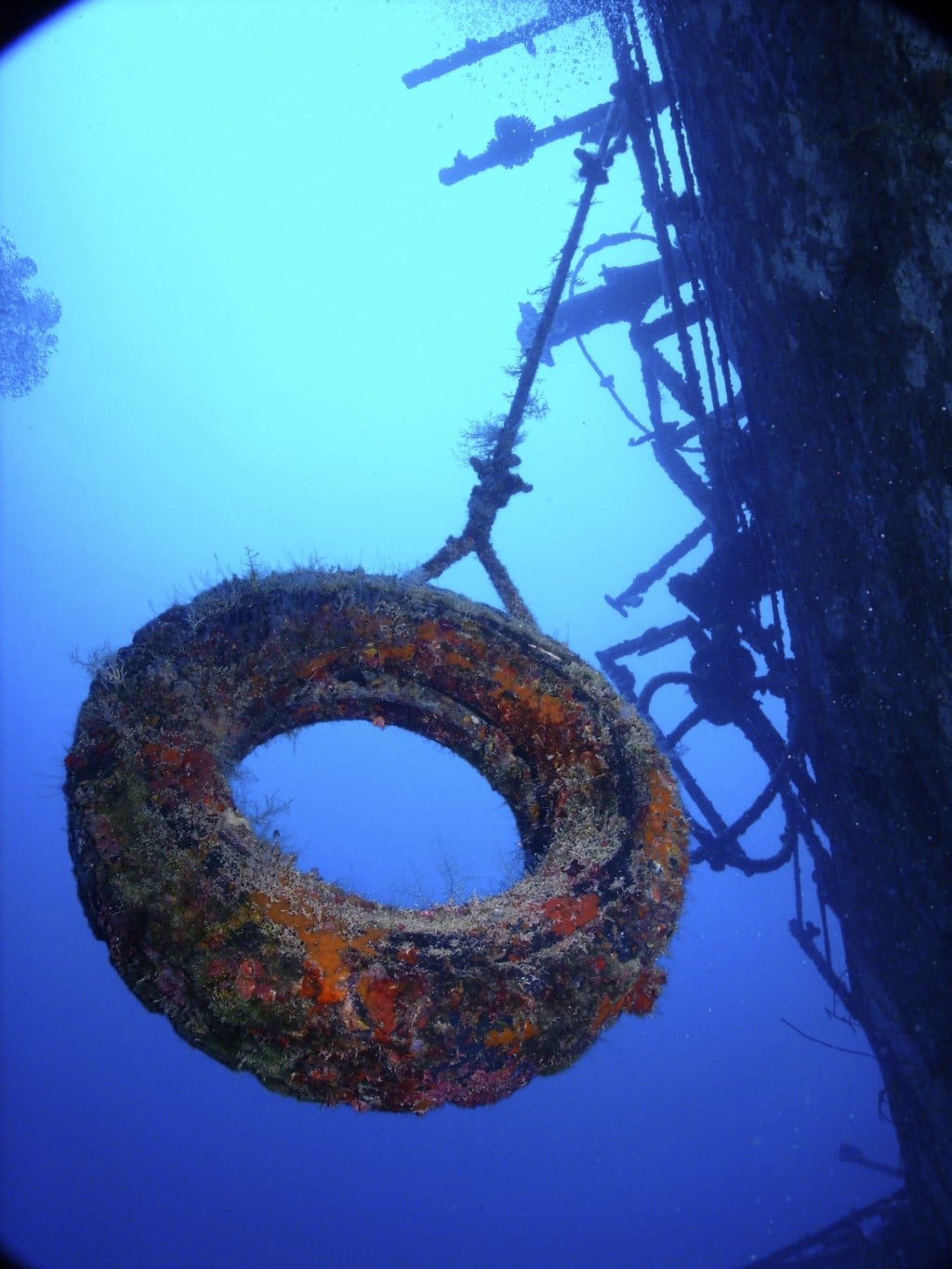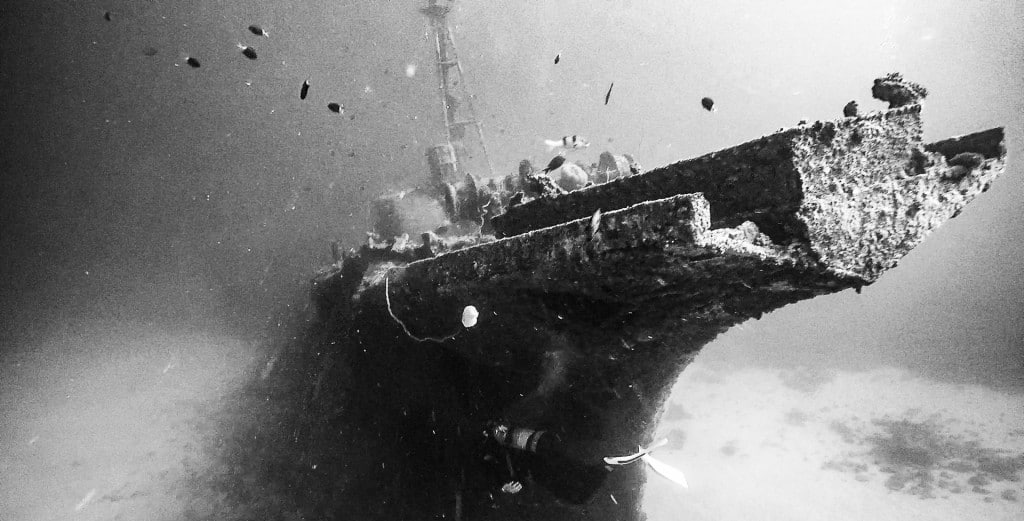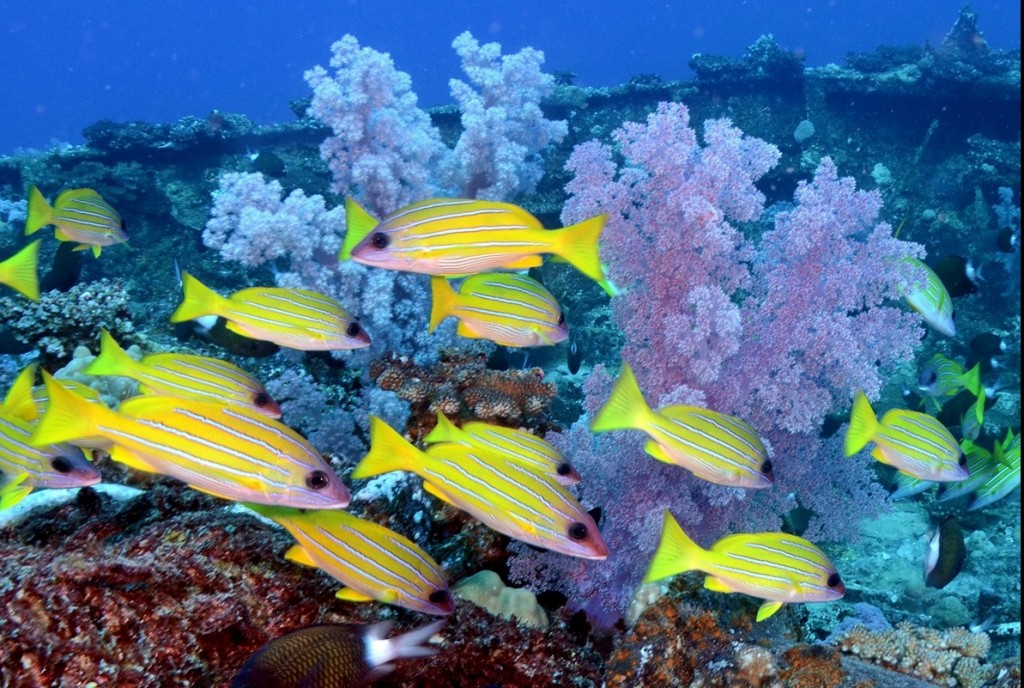Marine Life & Conservation
Diving the Wrecks of Mauritius (Watch Video)

Over 480 ships have been wrecked off the coast of Mauritius over the last 400 years. Most of them have disintegrated or disappeared. You will not be able to dive Le Coureur or the Saint Gerain, the notorious slavers of the 18th century that foundered with their human cargoes off the coast of Mauritius. They are now just a shameful memory and a collection of artefacts in the National History museum. Treasure hunters pillaged many of the earlier wrecks until the Mauritius Government banned the removal of undersea artifacts, and began sinking condemned ships to create artificial reefs.
Most of these wrecks are within easy reach of the dive centres in the North, and a Safari trip to Coin de Mire makes a great day’s diving. You take 2 or 3 tanks each, the boat loads up with delicious snacks, water or juice and often a light lunch. Coin de Mire Island, so called because it’s shaped like the wedge or quoin that gunners used to raise or lower the barrels of their cannons, is a National Park, and the breeding ground for the long tailed Tropicbird. It’s a short 10-15 minute boat ride.

The Djabeda wreck lies at an average depth of 24 meters, from 20 metres on the mast to 32 at the keel, with dense shoals of fusiliers and blue banded snappers, scorpionfish, two massive Javanese Moray eels, rays in the sand and exquisite corals. It was sunk in 1967, and parts of it have scattered across the sand, offering additional hiding places for marine life. There is a pair of sling-jaw wrasses living and breeding there as well, worth looking out for them as they are uncommon. It is also rich in colourful corals and almost fully intact.
After 20 minutes on the wreck, you fin towards the Island and decompress for the rest of the 50 minute dive time in Confetti Bay, an exquisite shallow site just off the Island, where you have snacks and prepare for the second dive. Bliss.

The Silverstar is 5 minutes from Pereybere, but its much deeper from 39 to 28 metres. It’s absolutely stunning, because it is in the deep blue, resting on the white, white sand, and looms out of the ocean like a fantastical pirate ship. Wreck penetration is possible for qualified divers. You need a good torch and once you are into the hold, it’s almost sinister, but filled with crustaceans and morays. Around the mast there are massive shoals, with a resident school of spade fish and orbicular batfish. This is a huge wreck, with an intact propeller at 40 metres, plenty of coral growth, and is best dived with Nitrox, but you need to watch your computer. It was sunk away from the reefs, so this is a short but dramatic dive.

Stella Maru is an old Japanese fishing trawler was deliberately sunk in 1987 by the Mauritius Conservation Society to create an artificial reef, and it is almost fully intact. It has the aggressive oriental look of those Japanese boats you see in WWII movies. It’s full of shoals of blue banded snappers, giant morays and scorpionfish, but it is also a fabulous photographic subject. We recently found a hairy frogfish there, and huddled against a broken portion of the superstructure was a very small gurnard, that amazing little guy with wings and legs like a crayfish.

The Emily and Waterlily were sunk in 1981, and they lie in fairly shallow water. They are a superb example of how quickly soft corals can grow, and how rapidly they become home to a host of tiny sea creatures. Both wrecks are abundant with soft corals and tiny juveniles, creating a photographer’s paradise with white sand, blue water and lilac, purple, blue and pink soft corals. This is often done as a 2 tank dive, with snacks on the boat and a visit to one of the coral and reef fish infested sites in the area nearby.

Pics: Thanks to Abdul Khathlan for the pic of the shoals on Djabeda.
Copyright 2018 Ocean Spirit, Mauritius – www.osdiving.com
Marine Life & Conservation
Paul Watson Released as Denmark Blocks Japan’s Extradition Bid

Renowned anti-whaling activist Paul Watson has been released from custody in Greenland after spending five months in detention. Denmark’s Justice Ministry rejected Japan’s request for his extradition, citing insufficient guarantees that his time already served in custody would be credited against any potential sentence.
The 74-year-old Canadian-American was arrested on July 21 in Nuuk, Greenland’s capital, when his ship docked to refuel. His arrest was based on a 2012 Japanese warrant related to a 2010 encounter in Antarctic waters. Japan alleged Watson obstructed operations and caused damage to a whaling research ship during efforts to disrupt illegal whaling. Watson has consistently denied these claims, maintaining his commitment to marine conservation.
Denmark, which oversees extradition matters for Greenland, concluded that while the legal conditions for extradition were met, the lack of assurances from Japan regarding time-served credit made extradition untenable.
In a video shared by his foundation, Watson expressed gratitude and relief, saying, “After five months, it’s good to be out… and good to know they’re not sending me to Japan.” He added that the most difficult part of his time in custody was being separated from his two young sons.
Watson is a pioneering figure in marine conservation, known for founding the Captain Paul Watson Foundation in 2022 after decades of activism with the Sea Shepherd Conservation Society. His bold efforts to defend marine life have earned him widespread support, including from celebrities and conservationists. His work has also been featured in the acclaimed reality TV series Whale Wars.
Watson’s lawyer, Jonas Christoffersen, praised the decision, stating, “We are happy and relieved that Paul Watson is now free.” He added that Watson is eager to reunite with his family and continue his vital work.
The arrest occurred while Watson’s vessel, the M/Y John Paul DeJoria, was en route to the North Pacific with a team of 26 volunteers to intercept a Japanese whaling ship. His foundation described the arrest as politically motivated and emphasized that Watson’s actions were focused on ending illegal whaling practices.
Japan resumed commercial whaling in 2019 after leaving the International Whaling Commission, asserting that whale meat is a cultural tradition. Conservationists, however, continue to challenge these practices, highlighting their impact on marine ecosystems.
Despite the challenges, Watson remains steadfast in his mission to protect marine life and bring attention to whaling practices. His dedication to ocean conservation has made him a globally respected advocate for the environment.
Marine Life & Conservation
12 Days of Zero-Waste Fish-mas

This holiday period, the Marine Conservation Society, the UK’s leading ocean membership charity, invites you to make some simple changes to eating fish this Christmas to help our seas.
Dr Kenneth Bodles, Head of Fisheries and Aquaculture at the Marine Conservation Society, said, “During the festive season, our consumption increases, but so does waste. Sustainability isn’t just about where food comes from – it’s also about how you use it. By reducing waste and making the most out of your seafood, you’re not only taking steps to be more ocean-friendly, but can also help to cut costs during what is often one of the most expensive times of the year”.
The Marine Conservation Society has compiled twelve tips on how to consume seafood sustainably with zero-waste this Christmas:
Buy whole fish instead of fillets
Instead of fillets, consider buying whole fish such as salmon, hake, or lemon sole. By adopting a “nose to tail” approach with cooking, whole-baked fish not only feeds a crowd, but also helps to minimise waste and maximise sustainability by using up every part of the animal, including bones, skin, and fat.
Make fish stock
Leftover fish bones or shells can be put to good use by boiling them to make a nourishing fish stock or bisque. This can be frozen and preserved for later use and makes for a flavourful base in a soup.
Make your own fish pâté
Avoid waste by turning leftover fish, such as smoked mackerel or salmon, into a delicious pâté by blending with cream cheese and lemon. Perfect when paired with crackers.
The sustainability of salmon and mackerel varies depending on where and how it is caught or farmed. For more information on green-rated options, check the charity’s Good Fish Guide.
Buy frozen
By purchasing seafood that is frozen or vacuum-packed, this helps to reduce waste by extending the shelf life of your food.
Fish pie
If you’re wondering what to do with leftover cooked fish, why not opt for a classic fish pie with mashed potatoes, leeks, and a cheesy sauce? A sure crowd pleaser on Boxing Day.
Use the head
Don’t forget the fish head! The meat is incredibly tender and flavourful. The charity recommends a cod’s head curry or recreating Fallow’s renowned cod’s head in siracha butter.
By stretching your ingredients further, not only is this a more sustainable way to enjoy seafood, but also cost-effective by repurposing leftovers and cooking creatively.
Boxing Day brunch
Mix leftover kippers or smoked salmon with scrambled eggs for a tasty, zero-waste, Boxing Day brunch.
For best choice, make sure you buy kippers, or herring, from the North Sea and the North Irish Sea.
Zero-waste storage
A top tip from the Marine Conservation Society to avoid waste is freezing fish offcuts to save for future use.
Crisp up the skin
Even leftover fish skin can be turned into a quick savoury snack by crisping it up in an air fryer with a little olive oil and salt.
Anchovies two ways
Leftover anchovies can either be blended with butter to make a delicious anchovy butter or tossed into pasta for a hit of umami flavour.
The charity recommends opting for anchovies caught in the Bay of Biscay for best choice.
Fishcakes
For an easy, zero-waste meal, leftover seafood trimmings can be mixed with mash and fried in breadcrumbs to make fishcakes.
Pickled mussels
Try pickling mussels in 1:1 vinegar and water, with a dash of sugar for a sustainable, zero-waste snack that can be enjoyed well beyond the festive season.
Mussels farmed in the UK are a seafood superhero. Grown using low-impact methods and harvested by hand, they get all the food they need from the sea around them. This makes them one of the most sustainable, ocean-friendly, and cost-effective seafood options.
Players of People’s Postcode Lottery have raised £6.6M towards the Marine Conservation Society’s vital work in making seafood more sustainable.
Laura Chow, Head of Charities at People’s Postcode Lottery, said: “Fish is a festive favourite for many, but making sustainable choices when it comes to how we buy and eat seafood makes all the difference for our ocean. Support from players of People’s Postcode Lottery has helped the Marine Conservation Society further its sustainable seafood work, so that we can all enjoy healthier, better protected seas.”
The Marine Conservation Society encourages you to make sustainable seafood choices a year-round habit, not just for Christmas. To check how sustainable the seafood on your plate is, you can visit the charity’s Good Fish Guide. The Guide helps consumers and businesses identify the most sustainable seafood using a simple traffic light system, based on where and how species are caught or farmed. Green is the best choice, amber means improvements are needed, and red indicates fish to avoid buying.
Zero-waste gift idea
Why not embrace a zero-waste Christmas by gifting a membership to support marine conservation? It’s a meaningful, low-waste gift that helps protect our ocean for generations to come. Memberships start from as little as £5 a month – the price of a sandwich and drink from your local coffee shop.
Find the latest sustainable seafood advice for wild-caught and farmed seafood on the Good Fish Guide, downloadable to your phone from www.mcsuk.org/goodfishguide.
-

 News2 months ago
News2 months agoIconic SS United States to become the World’s Largest Artificial Reef
-

 News3 months ago
News3 months agoBook Review – 52 Assignments: Underwater Photography
-

 Gear News3 months ago
Gear News3 months agoDYNAMICNORD – New German diving brand enters the British market
-

 News3 months ago
News3 months agoExploring Cenote El Pit: A Diver’s Dream
-

 Gear News3 months ago
Gear News3 months agoTry BARE drysuits (and maybe even win one!) this Friday with Sea & Sea at North West Dive Fest
-

 Marine Life & Conservation3 months ago
Marine Life & Conservation3 months agoBook Review: Coral Triangle Cameos
-

 Blogs2 months ago
Blogs2 months agoDive the Egyptian Red Sea this Autumn with Regaldive
-

 News3 months ago
News3 months ago2024 Ocean Art Underwater Photo Competition Announced















